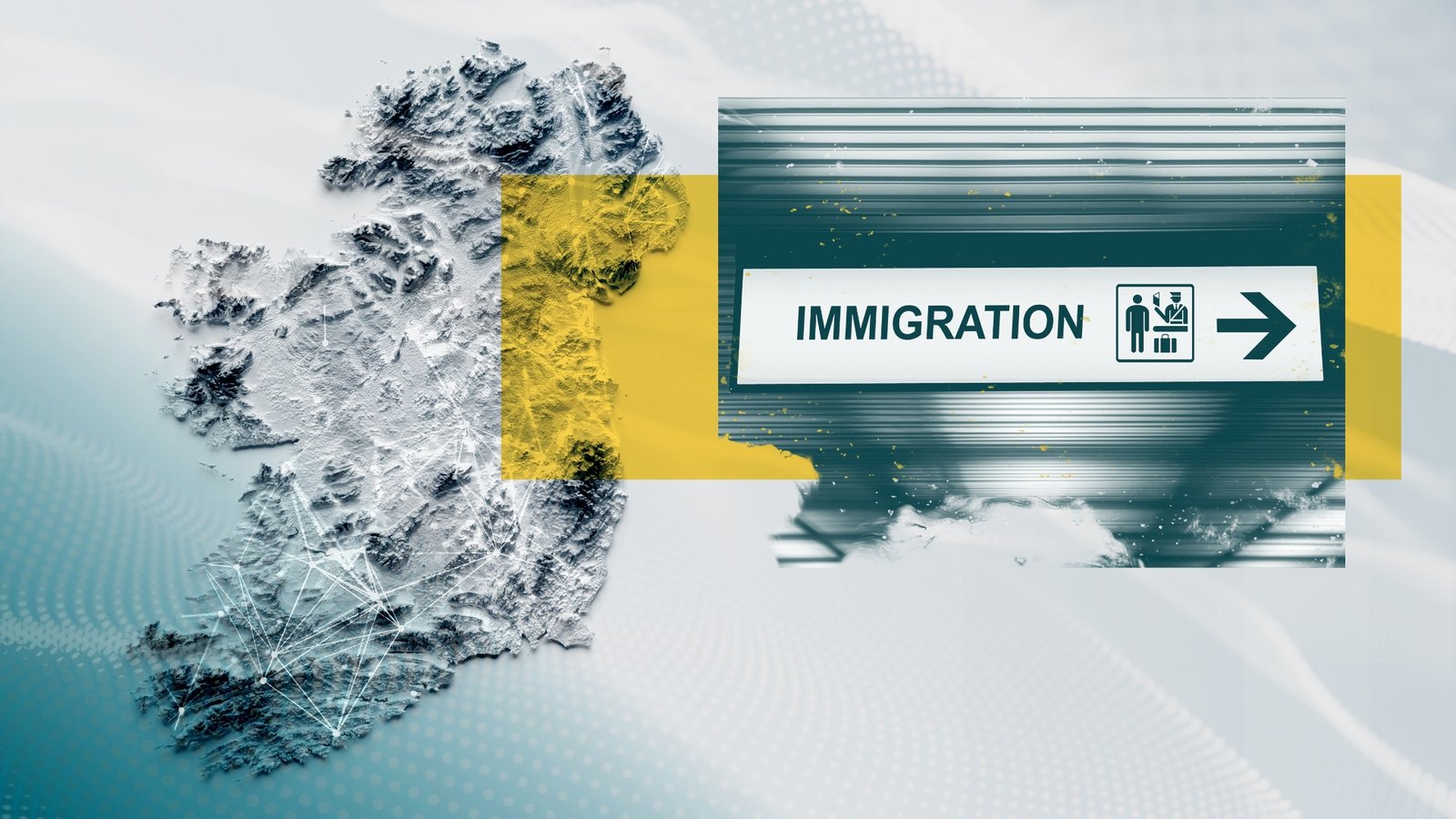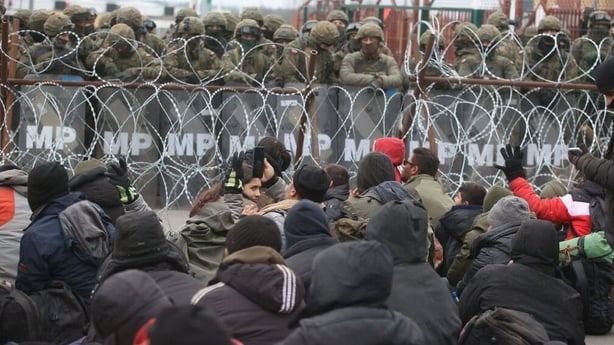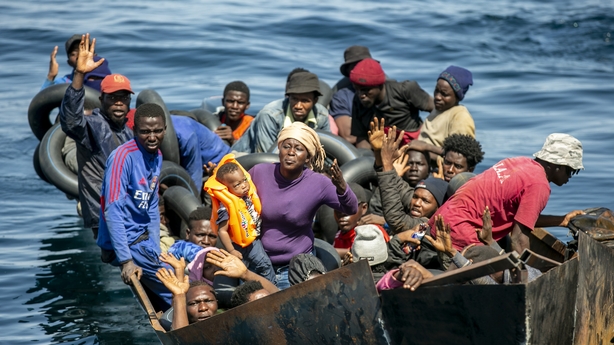Hell or high water: Tackling Europe’s migration dilemma

In a series of articles looking at the issue of immigration in Ireland, today RTÉ’s Europe Editor Tony Connelly focuses on how the EU has attempted to deal with the migration crisis and examines how Ireland’s response might be impacted by the EU Migration and Asylum Pact.
The migration crisis in 2015 was a seismic shock for the European Union.
Some 1.3 million people made dangerous and exhausting journeys across European borders, mostly from the Middle East, through Turkey, into Greece and then up through the Western Balkan route, but also across the Mediterranean from North Africa into Italy.
The vast majority were fleeing the vicious civil war in Syria, but others came from Afghanistan, Pakistan, Iraq, Nigeria, and Eritrea.
It was the largest movement of humans in Europe since World War II.
The response was predictably chaotic. Some EU member states like Hungary, Slovenia and Croatia closed their borders but when there was a build up at frontiers and at train stations, Germany and Austria decided to open their borders to allow asylum applications there.
It was a crisis moment for German Chancellor Angela Merkel, who famously declared: “Wir schaffen das”, or “We can handle this.”
Between 2015 and 2017, Germany took in 1.4m refugees. France accepted 276,000, Italy 240,000 and Sweden 205,000.
While the numbers declined after 2018, and fell to around 400,000 during the pandemic, the 2015 migration crisis created political fault lines that have only deepened and hardened.
A Pew Research Centre report in 2016 found that Europeans were increasingly antagonistic towards migrants due to a range of fears: terrorism, crime, pressure on housing and social services, a dilution of national identity.
There was a sharp increase in support for far right and nationalist/populist parties in Poland, Italy, Hungary, the Netherlands, Sweden, the Czech Republic, France and Germany.
Many commentators ascribed the migration crisis in Europe as a contributing factor in the Brexit vote.
An acute dilemma for the European Union
The EU’s founding selling points were freedom of movement between member states, humanitarian law and solidarity between member states in time of need.
Yet, facing domestic pressure over the numbers of newcomers, many member states preferred to close their borders, and reject the calls for help from frontline states like Italy and Greece.
At the height of the crisis, the European Commission proposed a burden sharing system, whereby 120,000 Syrian, Iraqi and Eritrean refugees would be distributed across member states according to their population size and GDP.

There was an outcry from central and eastern European countries. Hungary’s Viktor Orban accused the EU of wanting to “flood” his country with migrants.
By 2020, the Commission had abandoned the idea, but the need for Europe to rationalise its migration system was clearly not going to disappear. Migration, it seemed, would be one of the defining and most divisive issues of the 21st century.
After the pandemic, the numbers began rising again.
In 2022, total asylum applications were edging close to 800,000, but between January and November 2023, over one million people sought asylum, with 123,000 applicants in October alone – the highest figure since 2015-16.
The pressures were not just coming from the Middle East and Africa.
In 2022, Vladimir Putin invaded Ukraine, unleashing a brutal war on the civilian population.
With a fresh wave of refugees pouring over via Romania, Slovakia and Poland, the EU agreed to provide temporary protection, a mechanism which would grant more automatic rights for Ukrainians, including housing and employment.
By November 2023, some 4.3m Ukrainians were receiving temporary protection.
While there was broad sympathy for Ukrainians across Europe, their arrival coincided with asylum seekers from elsewhere, once again putting pressure on services, and fueling support for the far right.
Caught between the hue and cry about migrant “invasions” and horror at the increasing number of mass drownings of migrants in the Mediterranean, the EU made a fresh effort with a bold, if risky, set of proposals which coalesced into the EU Migration and Asylum Pact.
The Migration Pact attempts to square the circle: there would be a new, mandatory “solidarity” component, so that frontline member states like Italy and Greece are not left to carry the burden. Member states would be obliged to either take in a distributive share of migrants in times of crisis, or to make a financial contribution instead.
At the same time, there would be a more streamlined – and tougher – reality at the EU’s external borders.
There would be stricter health, identity and security screening of migrants coming in, with the beefing-up of the EU’s fingerprinting and biometric registering of all asylum seekers, known as Eurodac.
Migrants coming from countries regarded as relatively “safe” – typical examples tend to be Bangladesh, Pakistan, India, Tunisia and Morocco – would have their applications for asylum fact-tracked over a 12-week period, during which the applicants – including women and children (with the exception of unaccompanied minors) – would be kept in newly-built detention centres.

If their applications for asylum are rejected, then within three months they will be deported home or to a safe third country. There will be a reduced right of appeal.
For those coming from countries not deemed “safe”, then the normal asylum procedure will kick in. If hostile countries, such as Russia and Belarus, instrumentalise migrants (i.e, by funnelling them towards EU borders), then 100% of them will be corralled into the fast-track system.
The Migration Pact, which is nine pieces of legislation in all, received broad political agreement in negotiations which concluded on 20 December, but outside the EU’s institutions and national capitals it has polarised opinion: NGOs believe it is too draconian, the far right believes it does not go far enough.
The most sensitive aspect is the solidarity clause: there will be a solidarity “pool” where EU states offer to take in a percentage – based on population size and GDP – of at least 30,000 migrants each year. If only 60% of that 30,000 target is reached through voluntary means, then the remaining numbers will be allocated through a mandatory distribution.
Member states who decline to take in migrants under this scheme will be expected to pay €20,000 per migrant declined, and this money will go towards a total fund of €600 million, designed to help the member states who have taken in extra migrants, or towards the cost of enhancing screening and detention centres at the external borders, and towards search and rescue missions in the Mediterranean.
EU officials believe the pact is more hardline than previous efforts. “It is at the tough end of the spectrum,” says one official. “Amnesty International, Human Rights Watch, Oxfam and ECRE [the European Council on Refugees and Exiles] are all critical.”
Pact introduces ‘a harsher asylum system’
ECRE’s director Catherine Woollard told RTÉ News that the pact overlooks the fact that around half of those entering Europe need protection, and that they risk losing that status.
“The idea that treating people in a harsher way is a deterrent [is false],” she says. “It doesn’t change people’s need to seek protection, and it doesn’t change the global situation where so many people are displaced by war, persecution and conflict and violence.
“What the pact does is introduce a harsher asylum system, so more people will have their asylum application examined in second rate procedures. There’s a reduction in procedural rights – the right to an appeal is reduced, and people may even be deported before the appeal is heard.”
What’s often forgotten is that Europe has labour shortages in certain areas, and in parallel to the aims of the Migration Pact, which are about more swiftly separating genuine asylum seekers from economic migrants, the EU is under pressure to generate legal migration routes as well.
Yet, rhetoric about cracking down on migrants has entered the mainstream lexicon of centre right, and even centre-left parties (notably the governing Social Democrats in Denmark).
‘Embracing radical agendas’ makes it harder to find effective solutions
According to Alberto-Horst Neidhardt of the European Policy Centre (EPC), the reflex of pandering to such rhetoric undermines the need to have a “balanced” debate.
“Migration is a very complex phenomenon, and it can only be managed effectively if there is a balance of measures. Embracing radical agendas makes it harder to find balanced measures and effective solutions,” he says.
Neidhardt says that trying to forestall a far-right takeover in member states through stricter measures is adding fuel to the fire, and that in France and Germany, where centrist or centre-left parties have introduced stricter measures, they have only been met with demands for even harsher measures by the far-right.

In Belgium, where the Flemish far-right Vlaams Belang party is leading the polls nationally at 25%, the government has been at loggerheads with the main administrative court over a law announced last August to deny shelter to single male asylum seekers, putting hundreds of men onto the streets to live in tented villages throughout the capital Brussels.
“We consider the EU migration pact,” says Gerolf Annemans, a Vlaams Belang MEP, “as a continuation of EU policy, which means open borders, spreading the migrants, where there is no ceiling of the number of migrants that will be hosted, and they will be spread out all over Europe.”
Mr Annemans, who says if his party leads a Belgian government following elections in June they will call for the abolition of the pact, describes the lack of a fully-fledged deportation policy as one of its major failures.
EU officials admit that sending back migrants who have failed in their asylum applications will be one of the most challenging aspects of the pact.
First of all, the EU has very few formal treaties with third countries, which permit a returns policy (such agreements are more often the preserve of individual member states).
Third countries in Africa and the Middle East are reluctant to take back migrants because of the economic burden, and migrants themselves suffer from the shame factor.
Add to that the physical logistics of returning migrants to countries that are reluctant to accept them, and the problem of defining what makes a “safe” country (will it always be safe?), it is no surprise that the overall returns rate from the EU to third countries is around 24%.
The nature of modern migration also militates against clear-cut decisions: a national of Bangladesh, points out one EU official, might be regarded as coming from a safe country, but often Bangladeshis will seek temporary work in the Middle East, and when their contracts run out they go to Egypt and from there to Libya, which is frequently war torn (3,800 Bangladeshis arrived in Italy from Libya in November and December).
Where would such applicants be sent: fast-tracked or the regular asylum process?
Overshadowing the attempt at a standard, ‘tough-but-fair’ EU approach, is the growth in ad hoc bilateral deals between the EU, and between individual member states, and third countries.
These have been the subject of increasing concern among NGOs who fear refugees are being sent to perilous situations in order to satisfy far right demands.
The deals are about stopping boats in the first place, and sending back migrants who don’t qualify for asylum.
€105m to strengthen Tunisia’s coastguard
The most prominent is the EU-Tunisia agreement, signed in July last year by European Commission president Ursula von der Leyen and President Kais Saied, with Dutch and Italian prime ministers Mark Rutte and Giorgia Meloni present.
The deal is aspirational in nature, with binding commitments only happening later (once member states have approved them), with the EU providing an initial €150m in return for a range of joint projects, including migration.
Overall, €105m would be earmarked to strengthen Tunisia’s coastguard, given that it had become a major gateway for migratory flows from sub-Saharan Africa, and to take returns from Europe.
If the project is a success, more money, and an IMF loan, will be forthcoming.
What has angered many MEPs was that Mr Saied has become an increasingly authoritarian ruler, rebuked by the UN for alleging that “hordes” of sub-Saharan migrants were part of a criminal plan to change the ethnic and demographic nature of Tunisia.
Stung by criticism, and angry at the conditions attached to the deal, Mr Saied has sent some of the money back, so the arrangement appears to be in limbo.
Whatever the merits, the numbers crossing from Tunisia have fallen. “There is no evidence of migrants being pushed into the desert in Libya or Algeria,” says one EU official.
However, it’s been reported by the Times that Libya has now become the new bridgehead into Europe, with 10,200 Syrians, Egyptians, Pakistanis and Bangladeshis arriving in Italy from there in November and December, compared to around 2,200 Tunisians, Guineans and Ivorians who landed from Tunisia.
Italy’s prime minister Giorgia Meloni has become increasingly sceptical about the Migration Pact, mostly because she does not believe northern EU member states will fully embrace the solidarity mechanism and take on their own share of migrants.
Instead, she is placing her faith in bilateral deals with neighbouring countries, promising investment and legal migration options in exchange for governments cracking down on irregular migratory departures.
An ‘Italian Guantanamo’
In November, Italy signed an agreement with Albania whereby migrants that are picked up in the Mediterranean are whisked there to have their asylum applications swiftly processed by Italian immigration authorities who are based on Albanian soil.
Those whose applications are successful would be sent to Italy to continue the process, while those deemed economic migrants would remain in detention centres in Albania (with room for 3,000 initially, but up to 36,000 over time).
Already the deal has run into trouble. Opposition parties in Rome described it as creating an “Italian Guantanamo”, while the Albanian constitutional court issued an injunction in December over the notion of Italian officials operating on sovereign Albanian territory (the court will rule in March).
Despite the problems, there is every indication that some member states will pursue other bilateral deals above and beyond the Migration Pact’s arrangements.
Denmark passed a law in 2021 that any migrant arriving without papers would be sent to Rwanda unless they had specific reasons to fear persecution there (the measure has not come into effect because there is as yet no reciprocal arrangement with the Rwandan government).
The European Council on Refugees and Exiles (ECRE) says the Migration Pact simply encourages more outsourcing.
If there are increased responsibilities on countries like Italy and Greece to perform more stringent controls, then they are most likely to engage in push backs to prevent people arriving, according to ECRE director Catherine Woollard.
“The countries at the borders outside the EU will then have more responsibilities when people are denied access to EU territory,” she says.
A further issue is that of “safe third countries”.
Essentially, it means a country where the asylum seeker does not originate, nor where they seek protection.
Under the Migration Pact, if an applicant who has already landed in a first country of asylum and then made a so-called “secondary movement” to another EU member state, then their application will be rejected.
If they transited through a country outside the EU which is deemed safe, they can also be turned down for protection in the EU (the EU will establish a broader list of safe third countries in due course).
However, simply being designated a safe third country by the EU does not bestow any legal obligations on that country to take back failed asylum seekers.
Where does Ireland fit in?
Ireland is unique among member states in that it has an opt into migration and asylum measures when it suits, largely because we are outside the Schengen Area and share the Common Travel Area with the UK.
The Migration Pact is made up of nine pieces of legislation and Ireland has already opted out of one (the Screening Regulation, because it is Schengen-only) and has opted into one (the EU Asylum Agency Regulation, binding since last August).
Once the other seven pieces of legislation are fully adopted by member states, Ireland will then decide which they opt into and which they will opt out of.
It’s understood the Minister for Justice Helen McEntee will bring proposals to cabinet in March and once the cabinet takes a decision it will have to be confirmed by both Houses of the Oireachtas.
The mandatory re-location element, or burden sharing, to be balanced by a swifter returns policy, will effectively replace the long-troubled Dublin Regulation, which has governed EU asylum law.
Since some of the elements of the pact are interlocking, it may be difficult for the government to cherry pick which elements Ireland will opt into.

However, the government could decide that, rather than take on migrants from elsewhere, it could offer a financial contribution instead.
Speaking to RTÉ News in Davos, the Taoiseach said: “We have an option, which is to provide financial resources as an alternative to accepting more migrants under the pact and we will have to decide these things as the situation arises.
“At the moment, we’re having huge difficulty providing accommodation for people coming to Ireland and seeking international protection, so I think it’s more likely that we will decide to make a financial contribution than to accept more people.
“But these things have to be done on a case-by-case basis, and it will depend on how things develop.”
Once the Migration Pact is adopted – most likely before the European elections in June – each member state will have to draw up a national implementation plan to show how they expect to operate an uneasy mix of solidarity and toughness.
For that reason, it is not expected that the pact will become fully operational until 2026.
EU officials warn that there has already been a huge amount of disinformation spread by the far right about the pact, who claim that it will “let in millions”.
However, it is a huge overhaul of existing systems, which were designed before the great migration surge of 2015, and the new, high-volume migratory flows. As such, it will take time to bed in, and much can go wrong.
“Now there is a legal basis,” says one EU source, “a platform for either a very draconian, or a very fair system, but at least it will be transparent. All the elements will be in place in order to manage irregular flows. But there will also be a parallel system of legal migration in place, which should see one to two million coming legally to the EU every year, and that is against 1.5 million people leaving every year”.
Even if the Migration Pact is fully adopted by the spring, voters will not see results for at least another two years. In the meantime, the far right has won elections in Italy and the Netherlands, it is part of a confidence and supply agreement in Sweden, and it is leading the polls in Austria and Belgium, and in second place in Germany.
The European Council on Foreign Relations (ECFR) published a poll last week predicting a sharp shift to the right in the European elections, with parties of the “anti-European” populist right topping the polls in at least nine member states, and coming second or third in a further nine countries.
“We have seen across the political spectrum a shift to the right both when it comes to rhetoric as well as the policy measures that have been introduced,” says Alberto-Horst Neihardt, of the European Policy Centre. “I expect this to continue into the future, because the number of irregular arrivals cannot just simply be reduced or stopped all of a sudden. Therefore, far right parties that embrace the most radical agendas are going to continue receiving more and more support and visibility in the future.”
The problem facing centrist governments, who have long viewed the Migration Pact as the best way to outflank far right parties, is that voters who expect it to deliver immediate results will be disappointed.
Even when the pact is fully operational, its success will depend on so many variables that will be beyond the control of elected politicians.





